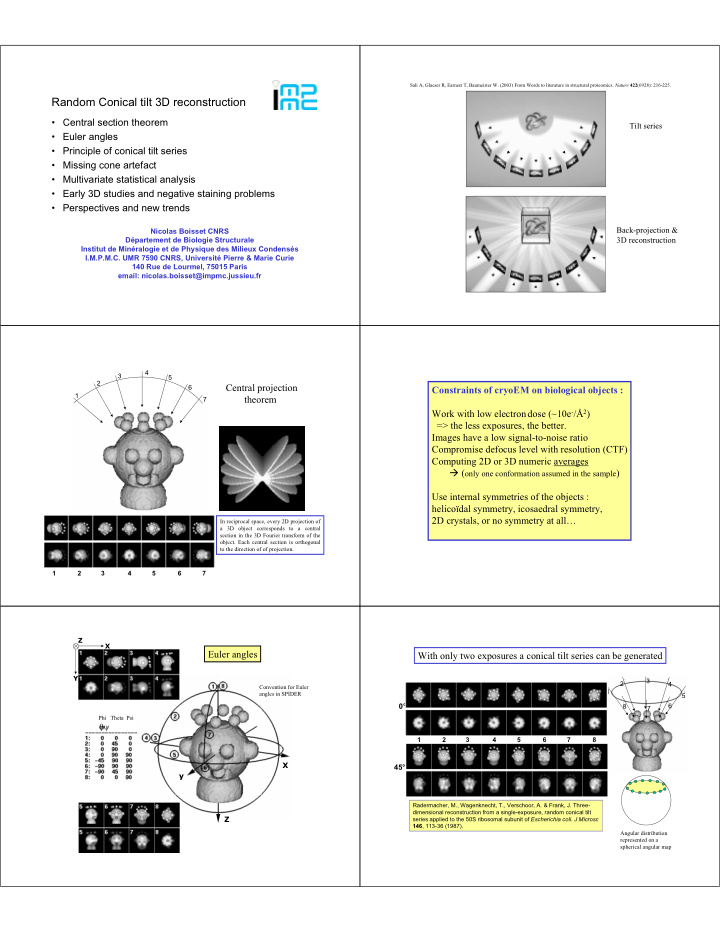



� � � � � � �� � � � � � � � � � � Sali A, Glaeser R, Earnest T, Baumeister W. (2003) From Words to literature in structural proteomics. Nature 422 (6928): 216-225. Random Conical tilt 3D reconstruction • Central section theorem Tilt series • Euler angles • Principle of conical tilt series • Missing cone artefact • Multivariate statistical analysis • Early 3D studies and negative staining problems • Perspectives and new trends Back-projection & Nicolas Boisset CNRS Département de Biologie Structurale 3D reconstruction Institut de Minéralogie et de Physique des Milieux Condensés I.M.P.M.C. UMR 7590 CNRS, Université Pierre & Marie Curie 140 Rue de Lourmel, 75015 Paris email: nicolas.boisset@impmc.jussieu.fr 4 3 5 2 Central projection 6 Constraints of cryoEM on biological objects : 1 theorem 7 Work with low electrondose (~10e - /Å 2 ) => the less exposures, the better. Images have a low signal-to-noise ratio Compromise defocus level with resolution (CTF) Computing 2D or 3D numeric averages � ( only one conformation assumed in the sample ) Use internal symmetries of the objects : helicoïdal symmetry, icosaedral symmetry, 2D crystals, or no symmetry at all… In reciprocal space, every 2D projection of a 3D object corresponds to a central section in the 3D Fourier transform of the object. Each central section is orthogonal to the direction of of projection. 1 2 3 4 5 6 7 Z X Euler angles With only two exposures a conical tilt series can be generated Y 3 2 4 Convention for Euler 1 angles in SPIDER 5 0° 6 8 7 Phi Theta Psi 1 2 3 4 5 6 7 8 X 45° y Radermacher, M., Wagenknecht, T., Verschoor, A. & Frank, J. Three- dimensional reconstruction from a single-exposure, random conical tilt Z series applied to the 50S ribosomal subunit of Escherichia coli . J Microsc 146 , 113-36 (1987). Angular distribution represented on a spherical angular map
Interactive particle Principle of random selection. Picking of Z X 3 conical tilt series 2 4 image paires (45° & 0°) Y provides a mean to 1 You just need to determine de 5 Euler angles specific to each compute the : tilted-specimen image. 6 8 7 Z • direction of tilt axis ( � ) • and the tilt angle ( � ). d D d D � = 0° � = 90° Reciprocal space � = in-plane direction of tilt axis If � parallel to axis Y, then � = 0° Radermacher, M. (1988) Three-dimensional reconstruction of single particles from random and nonrandom tilt series. J Electr.Microsc. Tech. 9(4): 359-394. � = Tilt angle => COS ( � ) = d / D (but you don’t know if it is + or – � � 2D alignment of untilted-specimen Interactive windowing images and computation of angle � at 0° and 45° tilt Rotation of each 0° projection by its - �� angle 2D projections are identical, 0° except for an in plane rotation corresponding to Euler angle � . Centering and masking of tilted- 2D projections are not specimen images 45° identical due to the tilt. Moreover, neighboring A circular mask hides particles start to overlap (up to a certain point) the neighboring particles. Simple back-projection Weigthed back-projection It is better, but we have a non- Why does it look so bad? isotropic reconstruction. Why ? Reciprocal space half-volume Reciprocal space half-volume � =36° � =36° � =36° � =36° Uneven distribution of the signal Missing cône Once the 3 Euler angles are determined, the 3D reconstruction can be performed from the tilted- Similar as previously, but after applying a band-pass filtering or R* weighting of the specimen projections. The simple back-projection is nothing more than adding in reciprocal space signal (lowering contribution in low spatial frequencies). the FT of the 2D projections in their relative orientations (waffle-like distribution of central sections), followed by Fourier transform of this 3D distribution to come back in real space.
Simultaneous Iterative reconstruction techniques (SIRT) Correct � value ? Real space & iterative: In real space with iterative methods, a The lambda value must be adjusted depending on the Global error quality and number of images and on imposed symmetries starting volume is computed by simple back-projection. Then, the volume is re- 1.0 projected in its original directions and � =36° � =36° 2D projection maps are compared with � to small the experimental EM images. The difference maps [(EM) minus (2D projection of the volume)] are computed 1 and back-projected to correct the 3D � to big reconstruction volume. To avoid “over- 2 correcting” the structure, the 2D 3 difference maps are multiplied by an attenuation factor �� � (with � � ~ 0.5 . E-04 � correct to 0.1.E-06). This process is iterated and 0.01 Iterations at each step the “global error” between EM images and the computed volume is measured to check improvement. Top views Comparing 3D reconstruction techniques The missing cone artifact Original object Simple back-projection Top views Front views Front views + = SIRT Weigthed back-projection + = In rare occasions, a single overabundant preferential orientation can distort your structure when using SIRT Interactive particle picking with determination of tilt axis direction ( � ) and tilt angle ( � ) even angular Titled-specimen 45° Untilted specimen 0° distribution uneven angular distributions 0° 0° 45° 45° Boisset N., Penczek P., Taveau J.C., You V., de Haas F., Lamy J. (1998) Overabundant single-particle electron microscope views induce a three-dimentional reconstruction artifact. Ultramicroscopy , 74 : 201-207.
Recommend
More recommend